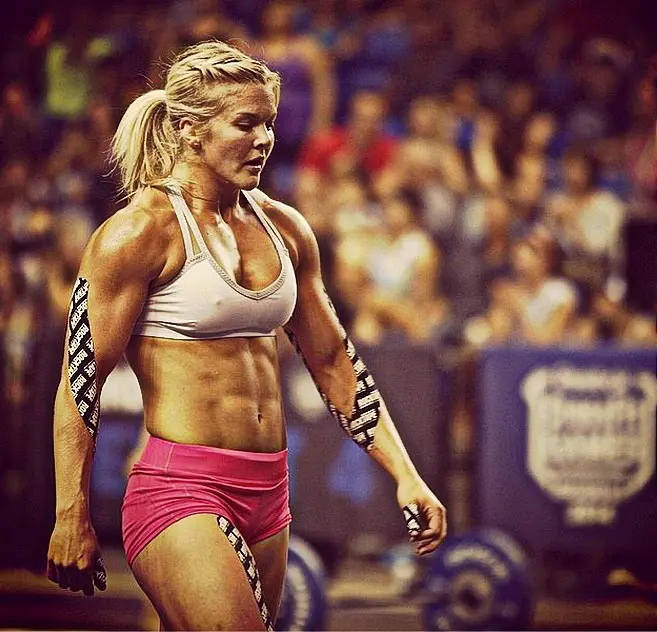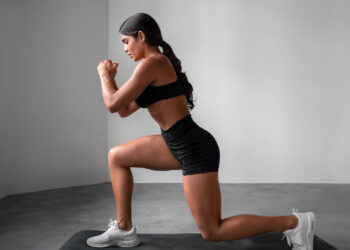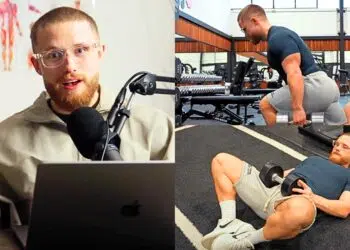Today we’re going to show you how to RKC plank, which is honestly a more worthwhile exercise than the basic, front plank. Now don’t get us wrong, the standard plank is a decent option to improve core strength. However, once you become decently good at them, you could hold a plank for several minutes and even hours.
At this point, you’re just testing your mental fortitude (nothing necessarily wrong with this). But we want to build real strength and this happens when we really push it with the intensity.
The RKC, Russian kettlebell challenge (also called Hardstyle plank) plank was actually invented by Soviet special forces trainer Pavel Tsatsouline (you’ve probably heard of him). Don’t let the name fool you though… there are no kettlebells involved. Tsatsouline is known to be a proponent of ‘whole-body tension’ and therefore has found a very effective method for improving the plank.
Let’s talk about how you can utilize it to increase your core strength and glute development.
How To RKC Plank For Stronger Core Muscles
There’s one main component of this plank variation that differentiates it from the basic plank… the amount of tension being applied.
The RKC plank consists of creating and maintaining tension in several muscle groups throughout the entire duration of the exercise. You’re not as relaxed compared to the regular plank and therefore, it’s much more difficult to maintain the position.
Level Up Your Fitness: Join our 💪 strong community in Fitness Volt Newsletter. Get daily inspiration, expert-backed workouts, nutrition tips, the latest in strength sports, and the support you need to reach your goals. Subscribe for free!
To do it:
- Get into a plank position so that your forearms and toes are supporting your body weight.
- Keep your body neutral and position your feet hip width-hip or closer with forearms parallel and directly below the shoulders.
- Tuck your chin while looking straight down at the floor.
- Unshrug your shoulders and squeeze your elbows toward each other which will externally rotate your shoulders. This should all be done isometrically, so you’re not actually sliding your elbows together.
- Adduct your legs by squeezing them toward each other and then flex your quads to completely straighten your knees.
- Tilt your pelvis down and in (pretend you have a tail and you’re tucking it under your butt) without breaking the previous form instructions and squeeze your glutes hard.
- Now pull your fists and toes toward each as hard as you can while squeezing your glutes even more. This is similar to if you were bending to form an upside-down V with your body but you’re actually not since this is an isometric hold movement.
- Hold this position for at least 10-15 seconds and then relax. Take shallow breaths during the hold.
Exercise tips
Here are some tips that we think will benefit you as you learn how to RKC plank since it may take a little adjusting. You may need to tweak the exercise instructions a little to fit your needs.
- Avoid rounding your back the best you can. Maintain a neutral body position although it’s OK to have a slight round.
- You can also place your fists together or interlock your fingers if it feels better for you, rather than keeping your forearms parallel.
- It’s best to keep your feet dorsiflexed (toes pointed toward your head) as this improves the engagement of the core muscles.
- Start out small and try to perfect the form before trying to challenge yourself to hold the position for extended periods. This is a challenging movement when done correctly and the focus should be the intensity rather than the duration.
- If you feel excessive pain or discomfort anywhere, stop and readjust or don’t continue if it persists to a very uncomfortable level.
Muscles Worked
The RKC plank works all of the core muscles, the glutes, back muscles, and the shoulders isometrically which means without contracting and elongating the ab muscles. Everything from the outer abs to the deeper stabilizers (transverse abdominis) to the obliques and lower back muscles pitch in to keep the body solid and trunk tense.
RKC Plank Benefits
Here are the main benefits of doing the RKC plank.
Builds muscles and strength
You should already know by now that it builds total-body strength because of the involvement in several muscle groups. Now, you won’t be able to go out and lift a ton more just because you do this exercise. However, you’ll be functionally stronger and because you’ve strengthened your core muscles, you should have improved support from the muscles of your trunk.

For example, you need a very strong core to support heavy squats. If you had a weak core, you’d likely have a very hard time progressing with this movement. Not to mention, it’s dangerous to have a weak core when trying to move heavy poundages.
And, the transverse abdominal muscles compress the contents of the core while helping to stabilize the spine. Therefore, strengthening these muscles is non-negotiable.
But let’s not forget about the glutes or butt muscles. Bret Contreras, well-known as ‘The Glute Guy,’ used EMG (Electromyography) testing to compare the regular vs the RKC plank. Well, he found that the rectus abdominis and obliques were activated twice as much during the RKC plank. But the glutes were also highly activated.
Level Up Your Fitness: Join our 💪 strong community in Fitness Volt Newsletter. Get daily inspiration, expert-backed workouts, nutrition tips, the latest in strength sports, and the support you need to reach your goals. Subscribe for free!
Injury/pain prevention
Strong core muscles won’t only help you to prevent injuries during big lifts, but oftentimes, lower back pain, and too much strain in this area, is a result of underdeveloped abdominal muscles. But because the lower back is also part of the trunk muscles, simply performing RKC planks will strengthen the muscles directly.
Better looking abs
The plank is an isometric movement but it still improves the development of the core muscles. Also, strengthening the deep core muscles can possibly give the appearance of a slimmer and more defined midsection. That’s because you’re training the muscles to stay tight.
The glutes also get some action too as you squeeze them during the plank.
Improves hip mechanics
Hip extension/anterior pelvic tilt is a key component of being able to effectively train the big compound lifts and other similar movements. Well, the RKC plank actually teaches you how to control your hip position so that you’re not using your lower back during extension.
The deadlift, for example, requires a strong hip extension. And one thing that you don’t want to do is extend your lower back. That’s why squeezing your glutes is so important to assist with the rigid position as you tilt your pelvis.
RKC Plank Variations
RKC plank too easy for ya? No problem, we have some great variations to turn up the level of difficulty so that you can continue to make gains.
Here are some excellent variations…
- Weighted RKC plank (throw on a weighted backpack or vest)
- Single-leg RKC plank (lift one leg in the air)
- Side RKC plank (great for working the obliques)
- Body saw
Who Should Include The RKC Plank In Their Exercise Routine?
Almost anyone can adopt the RKC plank to use it as a weekly core and total-body isometric strengthening tool. However, we recommend those with back or shoulder problems consult with a medical professional before attempting these types of exercises.
The RKC plank can worsen back and shoulder problems as it’s a weight-bearing and potentially straining movement that can adversely affect those with pre-existing injuries/pain.
It’s also a good idea to do some mobility work prior to attempting this exercise. This will ensure you’re warm, flexible, and able to execute the RKC plank most safely and effectively.
Wrapping Up
Now that you know how to RKC plank, use it as an advanced method to increase the difficulty of your core training. You’ll build your abdominals and obliques in addition to your glutes with this bodyweight-only exercise. Although, you can, of course, use the variations to take it even further.
Take some time to learn the exercise and then slowly increase your progress.
Interested in measuring your progress? Check out our strength standards for Deadlift, Hip Extension, Flutter Kicks, and more.









